Meet Sara Maestrelli, Creative Director of Collezione Em, a Boutique Hotel Group with Properties in Tuscany and Venice
Issue #143
Sara Maestrelli didn’t intend to get into the hotel business, but for those of us who appreciate beautiful boutique hotels, it’s a good thing she did. Though her family has been running hotels since the ‘90s, she studied neuroscience, clinical psychology, and philosophy. But once she got a taste of the hotel world, she realized that it was her true passion. Now she runs Collezione Em, which encompasses five hotels in Florence (where she grew up), Venice, and Forte dei Marmi, alongside her aunt Elena and cousins.
I met Sara when she launched Violino d’Oro, a member of the Leading Hotels of the World in Venice, which I reviewed for Condé Nast Traveler, and immediately felt a kinship with her. That was the first hotel she had a hand in designing and it’s truly a showcase of Italian craftsmanship. I was honored to work with her to create the inaugural issue of the Collezione Em magazine, which is available in her hotels, and to contribute an essay about Violino d’Oro in Culture: The Leading Hotels of the World, a new book published by Phaidon and Monacelli, which officially launched yesterday. This spring, Sara opened Pensione America, a Leading Hotels of the World member in Forte dei Marmi, and I had the privilege of being one of the first journalists to stay there too.
Sara is an incredibly smart, cultured, sophisticated, and unpretentious person. Every now and then, I ask her to be a source for one of my articles and she always graciously obliges. This interview was conducted in conjunction with a forthcoming article for Afar. I’m thrilled to share it as part of my series of interviews with creatives and entrepreneurs in Italy.
So how did you end up involved with Collezione Em?
Well, actually, I grew up always thinking that I would never work with my family because, when you're a teenager, you kind of have that mindset and then my interests were completely diverse. So I did study that out of passion and deep interest and then, when I finished my second master's degree, I didn't really want to get into clinical psychology. I was a bit curious about my family's business, because I thought it would always stay with me, so I might as well know what it was about. And so I started working with Elena at first, for a little while before I moved to Geneva.
Then I moved back, and when I started, I thought I'll do this for a few months, so I get a grip of how the company works from a hospitality standpoint, and that will be useful for me in the future, so I know what I'm talking about. That was my approach. It’s like this magic box you know nothing about until you actually start looking into it. And hospitality is such an eclectic and varied industry. At least the way I do it. It allows you to do so many different things that range from marketing strategy to interior design to working with craftsmen, and then obviously relating to guests and creating experiences within your territory, and allowing you to give a narrative of your destination and your properties, so it kind of sucked me in.
You're really involved with every aspect of the hotels, right?
Yes, not enough really, right now, because the new openings have taken a lot of time out of everything else, but every aspect, yes. So from drawing a wine list to literally building the property to talking to the guests, the menus, creating experiences, picking the linens and deciding what amenities go on the nightstand before the guest goes to bed, or so many other things. And I do a lot of work in the sales and marketing department, so there's also a lot of sales and sales strategy. And I travel a lot, which is wonderful, because sometimes I find myself on the other side of the world talking about the story of a city I live in and a property I also live in and love. And it's beautiful to be able to share that.
Grand Hotel Minerva was the first hotel, right? Can you remind me of the year your grandfather bought it?
Minerva was 1992 and my grandfather bought it as a real estate investment. He never actually worked in hospitality. It was part of the history of Florence, so it was a very beautiful, important, iconic hotel. But at the time, hospitality was something very different from what it is today. Now, everybody wants to invest in hospitality, but at the time, it wasn't necessarily such a business, but it was such an amazing, charismatic property. And then Elena started working at Minerva, and that's how it all came to life.
Since that period, how have Florence and Tuscany as a whole changed?
When my grandfather bought Minerva, it used to close in August for a month, so imagine how Florence—especially from a tourist standpoint, but also from the way it's lived—has changed. During the summer, the city would be empty.
When they bought it, the square of Santa Maria Novella, which is one of the most beautiful squares in Florence, in my opinion, was a little sketchy. It was more abandoned, and there were less shops around. The center was more concentrated. I can't remember that time, because that was 1992, but over the years, it's been growing and evolving, on one hand, I would say, in a good way. On the other hand, as much as it's true for every other city in Italy and maybe in the world, it’s losing some of its authenticity in terms of local craftsmen and shops that are being sold. So obviously, these two things go together.
It used to be a town of Florentines and Italians. Life was different. It was more simple. Everything was closed in the summer, there were only a few shops. You couldn't find everything, but you could find very specific things in Florence. And nowadays, like every city in the world, you tend to be always running, always going. You can find anything—all of the brands—and that carries, on one hand, comfort and excitement, many things to do, and on the other hand, it obviously loses a bit of its authenticity.
Florence has become—very similar to Rome and Venice—just so crowded, right?
Yes, extremely crowded, especially during some times of the year. But I have to say that now, thank god, people are traveling all year round. Obviously June is still different from November, but I think in the past two or three years, it's actually seen quite a high amount of tourists, even in what used to be called the lower season, and now maybe can be called the more beautiful season. So definitely, we've seen a lot of travel all year round. That has changed. But yes, overtourism is, unfortunately, an issue all through Italy and I imagine even the rest of the world.
Are there still neighborhoods that are not overrun by tourists? Obviously, Florence is smaller than Rome, but in Rome, there are still quite a number of neighborhoods where tourists just don't really venture to. Does Florence have those kinds of areas?
Four or five years ago, I would have probably said Santo Spirito, but then it became really popular as well. So I would probably say San Frediano, which is the alternative neighborhood that is a little further away from the center, and Sant’Ambrogio, which, curiously enough, is much more local. It also has some beautiful markets for fruit and vegetables, meat, and the antique market. But also it's where most of the American students that study in Florence live. So it's less touristy, but then it's full of American college students.
Restaurants too, right? All the Cibreo restaurants are there?
I would probably say these are the only ones that come to mind that are really good in Sant’Ambrogio, but they're all there. So there's the Cibreo Caffè, the trattoria. And then there is Cibleo, which is the fusion of Japanese and Tuscan cuisine, which is super fun and a very interesting dining experience. Personally, Cibreo Caffè is my favorite. So I usually don't say it when I have to talk about my favorite restaurants in Florence, but anyway, all of their restaurants are incredible.
The market there is also very nice to visit on weekends. And the fruit and vegetable market, if someone is staying a little bit longer, maybe staying in a home, it's really nice. They also have amazing meat. So it's a place where you definitely can live the city a bit more. The only thing is that in the evening, it's full of college students, American and Italian. But it always depends on where you go. There's also a very great bar. Locale, I think, can be considered in Sant’Ambrogio, which is one of the top 50 bars in the world.
Are there alternative museums or cultural sites that are more under the radar that you would recommend?
So first of all, my recommendation is to visit some of the cathedrals and churches. Some of the churches have these hidden, incredible masterpieces. The Chiesa di Ognissanti has a crucifix by Giotto that is amazing. And I mean, you go and visit museums, but a lot of the art masterpieces are in the churches.
So it's something interesting to do. Florentines do, and some tourists, I imagine, do, but nobody visits the churches like they visit the Uffizi. You just walk in respectfully, of course, and there's this wow. Visit the cathedral of Santa Maria Novella, which is the one next to Minerva, because I think it's the most beautiful one in Florence.
And then recently, they have discovered and opened a place called Le Stanze di Michelangelo. Basically for a while, Michelangelo was not kept prisoner, but I think he was hiding, and he was living in this kind of basement, and for one year he drew on the wall, and recently they rediscovered his drawings. So for anyone visiting Florence now, it's something very interesting to go and see.
And then also, I know that when we talk about Florence, we always think about the Renaissance and more ancient arts, but Palazzo Strozzi holds a lot of very interesting, beautiful contemporary art shows.
And what about beyond Florence, for readers who want to see an authentic side of Tuscany away from the crowds? What other towns should they visit, or even geographic areas that are less crowded?
The countryside is always a little bit crowded, but if you're staying in Florence for a little bit longer, I also recommend going to have a beautiful lunch somewhere that is not too far away from Florence. It's something that is very typical of the way we live.
As long as it's not raining, even in the winter, if it's a little bit sunny on a Saturday or Sunday, we will do a gita fuori porta. So we'll take the car and we'll go somewhere for lunch that can even be literally, 20 minutes away from town. And you go for lunch, and it's usually these very authentic, rustic places where you have the bistecca fritta, which is a steak that is deep fried, which you digest in a week. So that's also fun to do. And usually there are no tourists around, just Florentines.
And then Val d’Orcia is probably one of my favorite areas. And this could be a little bit of an off season tip. Personally, I go to Posta Marcucci. It's the same owners as La Perla, but in Val d’Orcia. I went for my birthday this year. At least once a year, I spend at least one night just to get away from it all at Posta Marcucci.
Val d’Orcia in the winter is not the same scenery as the summer, because the typical thing of spring in Val d’Orcia are all the green hills with the trees, and in the winter it's obviously a little drier, but still very beautiful. So someone traveling in November or December, which is a wonderful time to visit Tuscany and Florence, can also consider going to Val d’Orcia off season. But it's not off season because at the same time, you can do things like swim in thermal waters with all the Val d’Orcia around you, which is wonderful. I went last year in December, and sometimes it even snows a little bit. So it's the same place, but it's a completely different experience.
Okay, I've heard of it, but I haven't been there. I've been to the Terme di Saturnia, which is a bit further south in Maremma.
Much further further south. It's very different. So the Terme di Saturnia is historic, iconic, but it's much bigger. And the surroundings are different. You're almost on the border of Lazio, whereas here you're in the creme de la creme of the Siena countryside.
You have to go visit Posta Marcucci. It's a very small boutique hotel with all the hills around it. I went for Christmas. It was beautiful. They had Christmas trees everywhere, and it really feels like you're in this old three star pension, but everything is very curated. And we were playing cards, and they were making cocktails. They have a record player, you put your own disk in.
I guess Val d’Orcia is not an original tip, because everybody goes, but my recommendation is to go for Christmas. If you just get a car and get lost around Chiantigiana, all of the small towns close to the Christmas markets are really cute.
One of the things that I really love about Tuscany, that I think a lot of travelers miss, is the coast. People tend to think of Tuscany as the vineyards and the countryside, but Tuscany has such an amazing coastline, from Forte dei Marmi down to the Maremma, right?
Yes, definitely. And also, the special thing about the coast of Tuscany is that it's almost all sandy, which is not necessarily very common. There are very long sandy beaches in the north, so all over the Forte dei Marmi area, which you know, I'm in love with. And then you go south from that, you have all of the area around Castiglioncello, which is more rocky. As a Florentine, every one of my friends has a different perspective on the place. My best friend is in love with Castiglioncello. I think it's not really my cup of tea, but everybody has their preferences.
And then you go down to the southern part of Maremma, which is beautiful. All the area around Argentario is very rustic, I wouldn't say too touristy, for sure, very Italian. Not many services either.
I go often around the Argentario area, because I have multiple friends there. It's wonderful, but it's hard to go out for dinner. Then you go south towards Capalbio, and that's a very sophisticated but very radical vibe, with beaches. But also the special thing about Capalbio are all the beautiful estates in the countryside around it and lots of lovely, small restaurants. And it's becoming more and more lively. It's very popular with Romans because it's somehow closer to Rome than it is to Florence, and there are definitely more Romans than there are Florentines in Capalbio.
And the Tarot Garden. Have you been there?
Yes, I have a friend whose house is literally in front of it, and it's really unexpected. The first time I went to visit him, I didn't know about the Tarot Garden. And I was like, “What do you have in front of your house?” Because you're in the middle of the countryside, in the middle of nowhere, you're driving your car along a bumpy road. And then you turn around and you see these kaleidoscopical things coming out of the pines. Someone had a huge trip here. It's really, really cool. And there's a lot of art going on.
And speaking of art, Pietrasanta...
We found out a lot, even recently, about the story of Pietrasanta. I didn't know this before, because I knew that Pietrasanta was a hub for artists, and that many artists from all over the world had become residents in Pietrasanta, including Botero and Mitoraj and so on. And I didn't really know why. But it's quite obvious, really, because of the foundries. They appear to be the best in the world.
And so this is a reason why artists, especially artists that make sculptures, live in Pietrasanta for a while, because that's where they produce their art. And so for that reason, it became this hub of artists. And therefore many art galleries opened. And we're talking about, a piazza and literally four streets. There's nothing else. So there's a huge concentration of art galleries and art shows. And it gives it a very special vibe, because there are cute little restaurants and that beautiful square and you're sitting there having a Negroni, and the sun goes down and everything becomes pink and you can kind of feel the magic.
I loved it. I was so charmed by Pietrasanta, and I didn't know anything about it before you recommended it. Are there other secret little towns that you don't want to tell?
No, that is only true for restaurants in Florence. Because Cammillo. Honestly, it's not because I went, but we all raved about Cammillo in Florence. Everybody did it for such a long time, with travel advisors, with journalism, and now you can't go to Cammillo anymore…
So I think one of the wonderful things about Tuscany is how varied it is. And that's not news. That's the reason why it's one of the most popular destinations in Italy. The beautiful thing is that there actually is a lot more to discover still.
If you want a change of scenery, which is something that we do a lot during the summer, there's also the Apuan Alps. So you can go trekking, which is probably the most pleasant thing to do also, because in the summer, it can get quite hot on the coast, whereas if you go up, the temperature drops. You bring a sweater where you're sweating down on the coast. It's quite chilly, and you can easily trek for like, four or five hours. And there are all these small rifugi which are the mountain huts that you can find in the mountains and the Dolomites. And there's one that’s my favorite. It's called Rifugio del Freo, and the food there changes completely.
So if you're starting from the sea, where you’re eating spaghetti on the beach and Vermentino, and then you go up, you hike for three hours and you get to Rifugio del Freo and suddenly, you're in the mountains, so their local food is more like tordelli ripiene di patate, ragù, crostate, and all of these typical things from that area.
And it's not hot. It's wonderful. And then you can trek back, or sometimes we go to Le Polle, which is this beautiful river in the Apuan Alps, where these big round crystal clear pools form. And so we go swimming there, and the water is freezing cold. And it's very refreshing when in Forte dei Marmi it's really hot in the summer, and that's just an hour away.
If I spend a week with friends in Forte—and usually I spend the entire summer on and off—we'll definitely go to dinner in Pietrasanta, we will also go trekking, and then we'll also go have dinner in one of the small restaurants that are up more on the mountains, and there are a few ones that have an incredible view and incredible scenery.
Are there other experiences that you would recommend people have in Tuscany, like gardens, farms, or wineries?
I love Castello di Ama. You probably know about it already, but I love it because of the art shows that they have. Apart from the wine, that's amazing, but it's also beautiful to do something that is not just wine tasting. They have these beautiful site specific art shows going on. And also the wine is really, really good, and the place is amazing. So it's a full Tuscan experience, where you have the landscape and the arts and good food and wine tasting. And so I definitely recommend a tour of Castello di Ama.
Again, we're blessed in Tuscany with a great variety, even in terms of wine. So even if you come back multiple times, it's not like, “I've done the wine tasting, that's it. It's finished.” Because in different areas and in different wineries, it can be a completely different experience. So, for example, all of the Super Tuscans around the Bolgheri area, that's incredible, and that you can easily do from Forte dei Marmi because it's like half an hour, 40 minutes away. Or you can do it if you're staying around the Maremma, which is also very beautiful, and that's a different countryside scenery, and also a very great wine experience.
Then clearly, there's all the Chianti region, and I would say that around Florence, Cantina Antinori is worth seeing because it's really an architectural—I wouldn't say masterpiece—but they did a great job. They built the entire cantina within the hill so they could prevent the heat from forming and keep it cool. And so there's this beautiful fusion between architecture and nature within cantina Antinori. And obviously it's Antinori, so it's one of Italy's most important wineries. And so your experience doesn't have to end at wine, but it's a more interesting all around cultural experience.
If you spend more time in Florence, it's also fun to visit the smaller wineries, especially if you can have a more immersive experience, or maybe if you can sleep there, or if they can show you a little bit of the background of that. And then if you're staying in Forte dei Marmi—and this is something I always tell our guests—there's a lot of wineries coming up in and around Lucca.
So Lucca is another incredible city that I always recommend our guests visit, as opposed to Pisa. Every time a guest comes from the US, usually they want to go to Pisa, and I'm like, “Go to Lucca.” Lucca is really beautiful, and Pisa just has the leaning tower. Around Lucca, there are many nice wineries. And again, it's a different experience. So wherever you go, find the local, typical winery and go visit it and see how the scenery and the product changes.
How do your hotels help guests experience a more authentic side of Tuscany?
It really depends on the hotel, because Florence and Forte dei Marmi are two different experiences because the way you are vacationing if you're spending two weeks in Forte, and the way you're vacationing if you're spending two days in Florence, which is the average night stay in Florence, varies a lot. So obviously, in Forte, we have much more fun with our guests. We have quite a few guests in Florence that are repeaters and that come every year because they love Florence, and maybe they spend two weeks there. One of them spends two months every year.
With those guests, we have a lot of fun, because when you're staying longer, we have a chance to get to know you better. Then I think it's very simply the magic of a family owned hotel. There's no special trick to it. It's simply sitting down together and having a coffee and trying to figure it out, like a conversation with friends. And if you were a guest and we were sitting at the hotel, I'd probably say, “I think you should go there. Let me call them.”
It's as simple as that. And that extends to the concierge service. So we try to convey that experience, even if you’re staying for two nights and you don't get a chance to really connect with us. Everything that our concierge comes up with, we study that together. Some of them are experiences that are offered by friends and people we know, and so we have a special kind of insight and a special access.
All of them are vetted by us. So we never recommend something that is touristy or because the experience pays the concierge. That kind of situation that can happen. In our case, it never does, because we're physically there, and it's our passion to offer a real insight and a real experience in Florence. So everything is vetted, everything is studied together with love, and obviously, the longer they stay, the more we're able to convey that.
Then in Forte, it's very different and much easier, because, as you saw, there's a lot of interaction with the guests, and everything is much slower. So for example, the other day, I was at Pensione, and a very big family from South America checked in. And like usual first timers, they had a huge list of things that they had planned already and booked. And so they knew that they were going to this place for dinner. And then the next day they were doing Carrara and all of the marble quarries. And then they were doing this, and then they were doing that. And we started talking, and by the end of the chat, everything had changed in their itinerary and I actually felt a little guilty, because the front desk manager was looking at me like, “What the fuck are you doing?”
Obviously, you can do that when you have 18 rooms and they're staying for a long time and the check in process can last an hour. It's more difficult to translate that to a city hotel where there's a much quicker turnover. We try to do that as well. We always also put the magazine in the rooms with all of our stories. We try to leave them information that they can pick up throughout the hotel as well.
Further Reading
You can learn more about Culture: The Leading Hotels of the World, which has beautiful photography and stories about more than 80 member hotels around the world, and order a copy here.
Curious to learn more about Sara’s hotels? Check out my aforementioned reviews of Violino d’Oro and Pensione America for Condé Nast Traveler.
In case you missed it, I dedicated an issue of the New Roman Times to Forte dei Marmi earlier this month.
I also included Sara’s insights about Venice in this article for Afar about how to visit Venice without the crowds.
You can read all of the interviews in this series here.


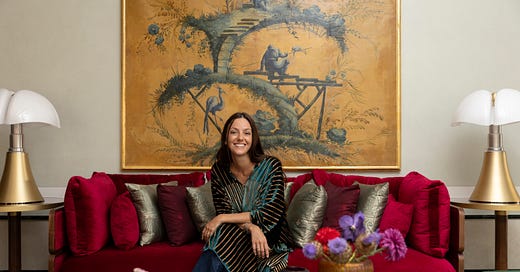



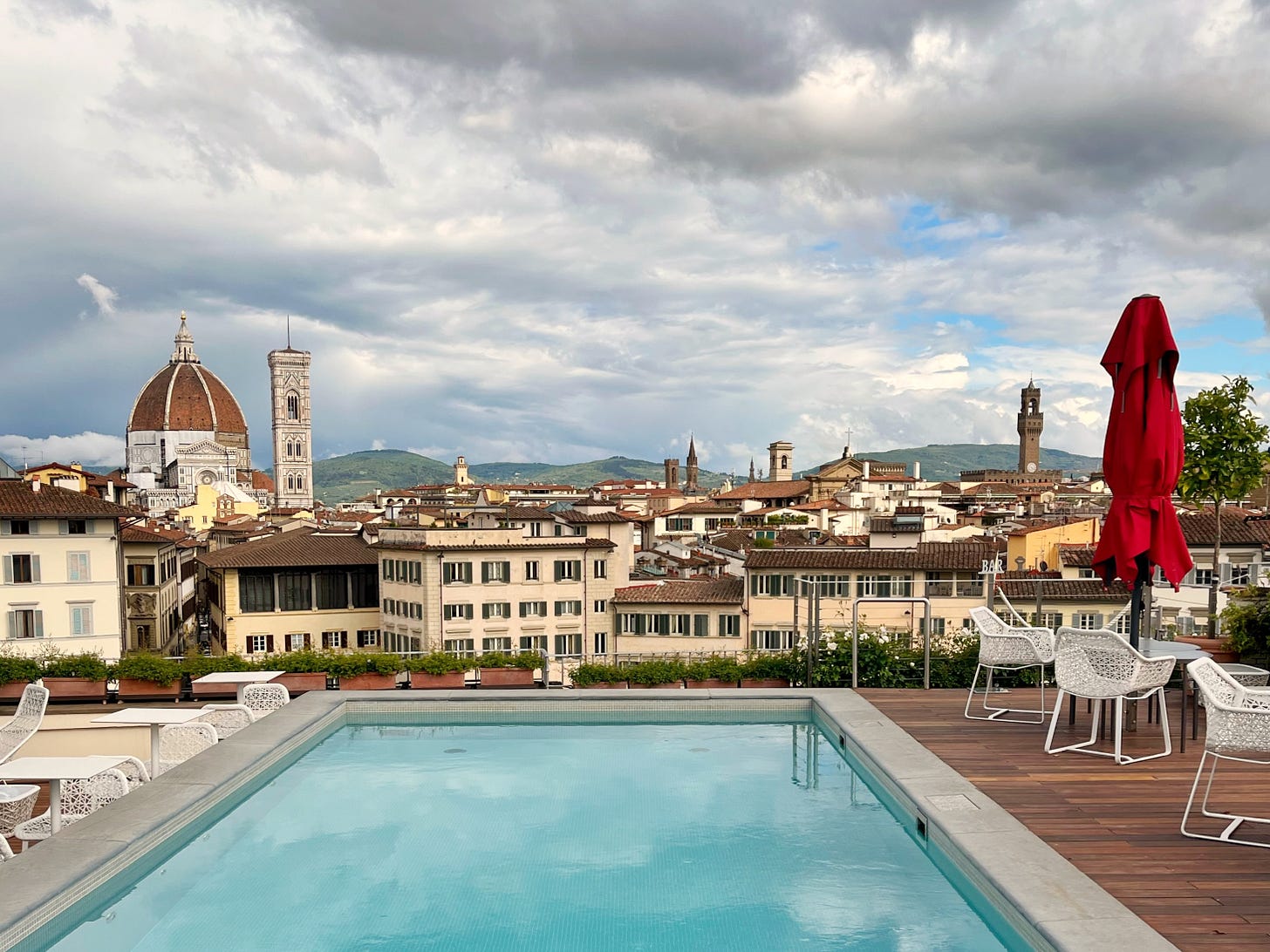
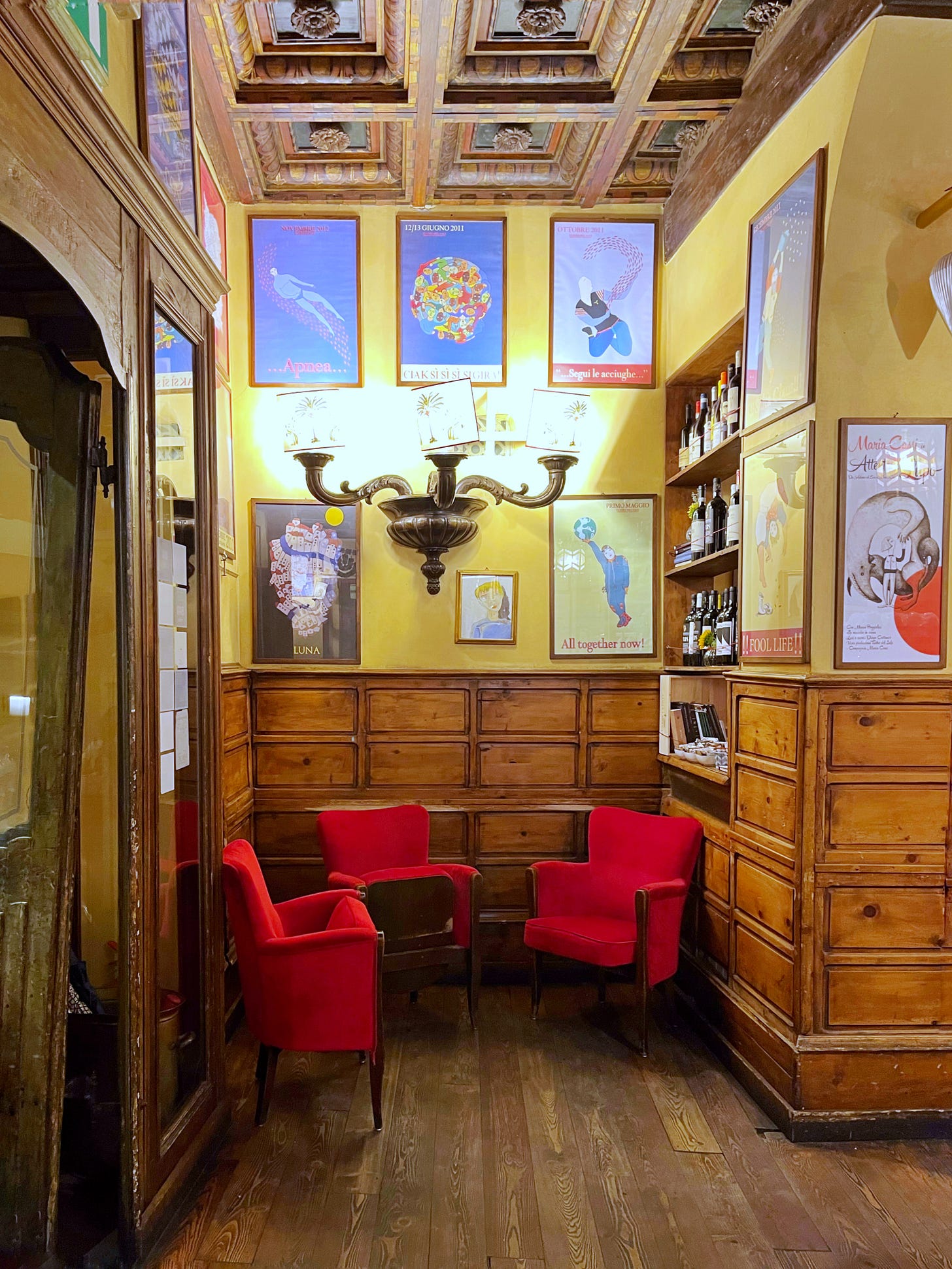
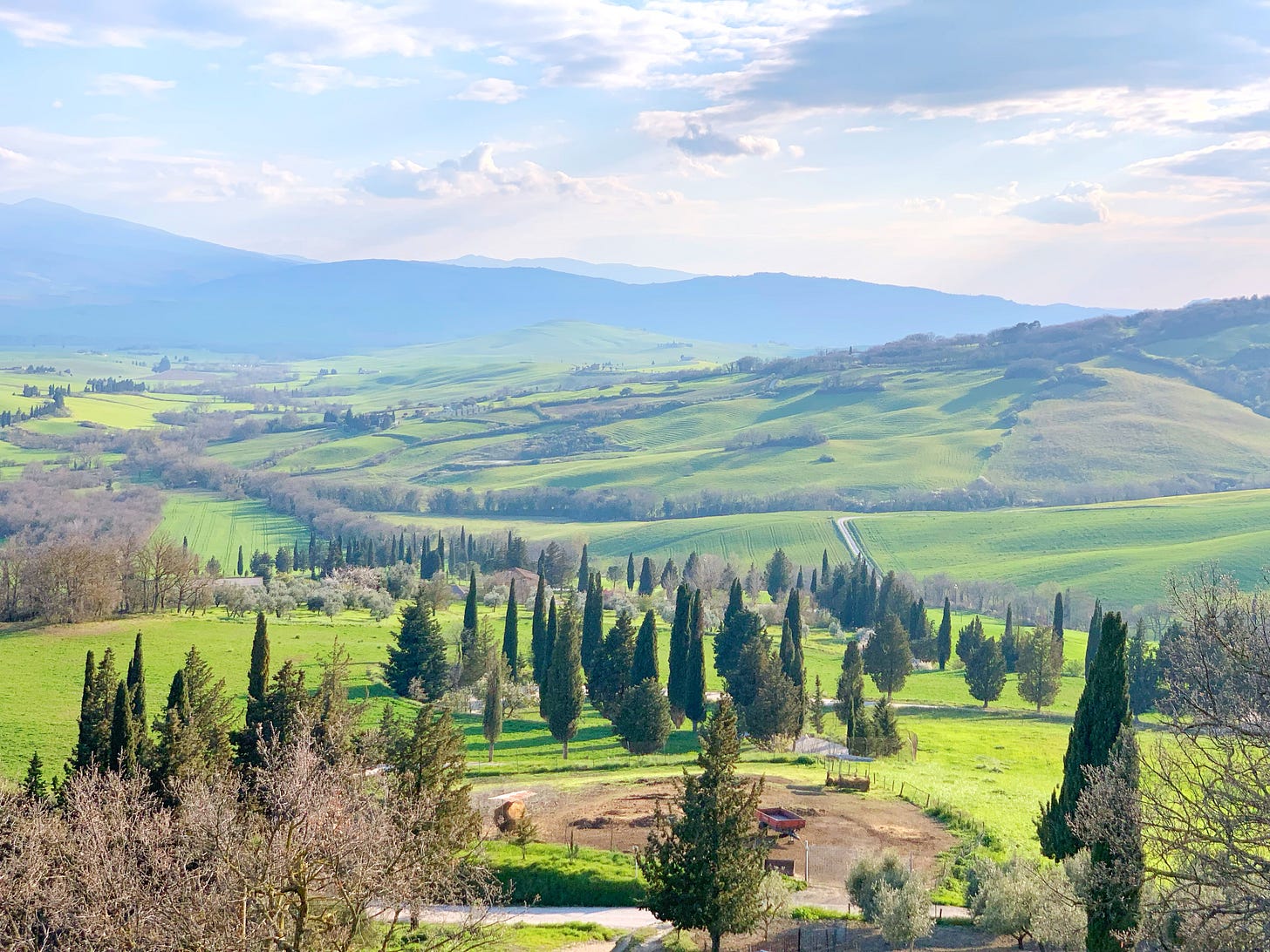
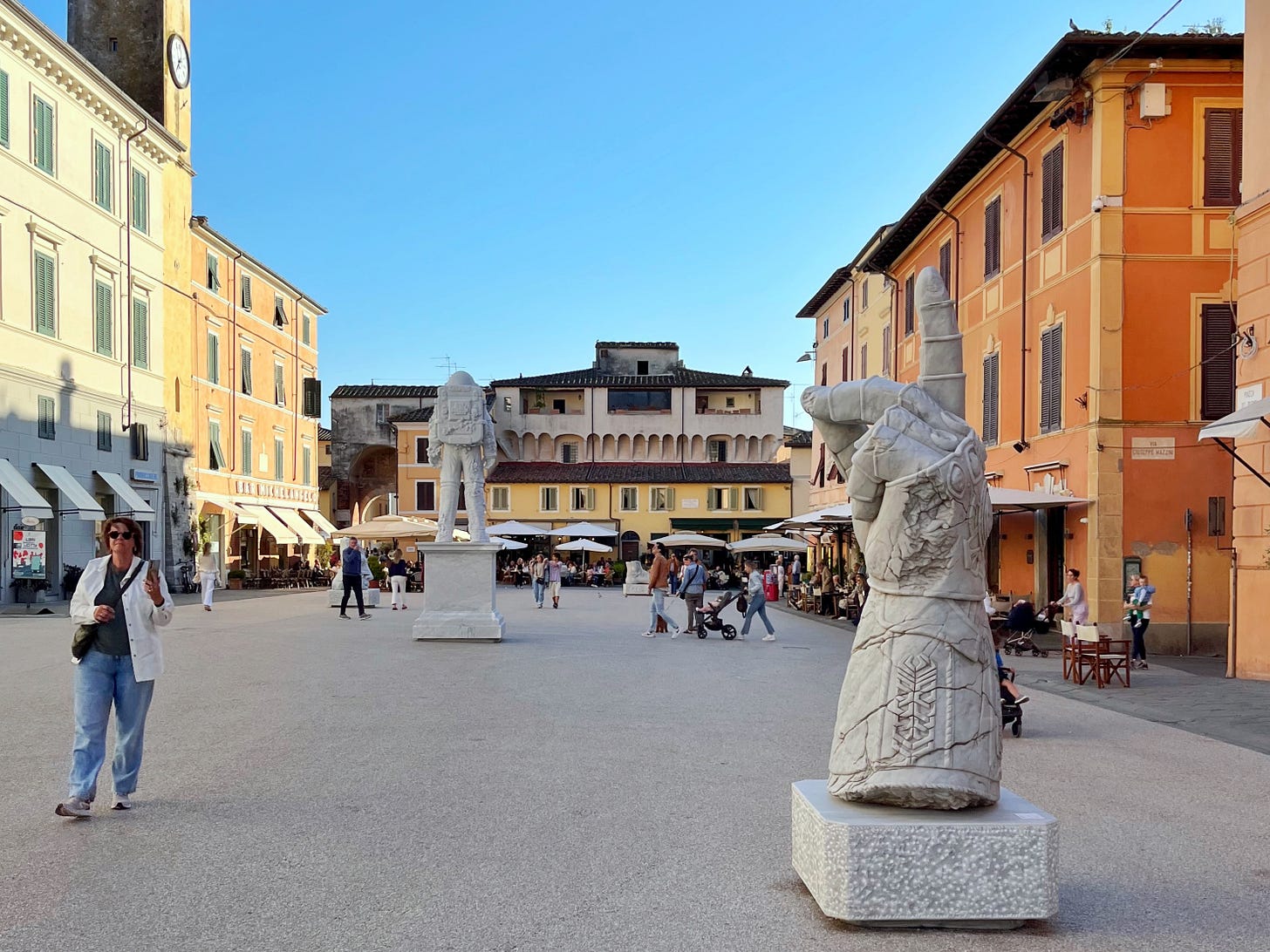
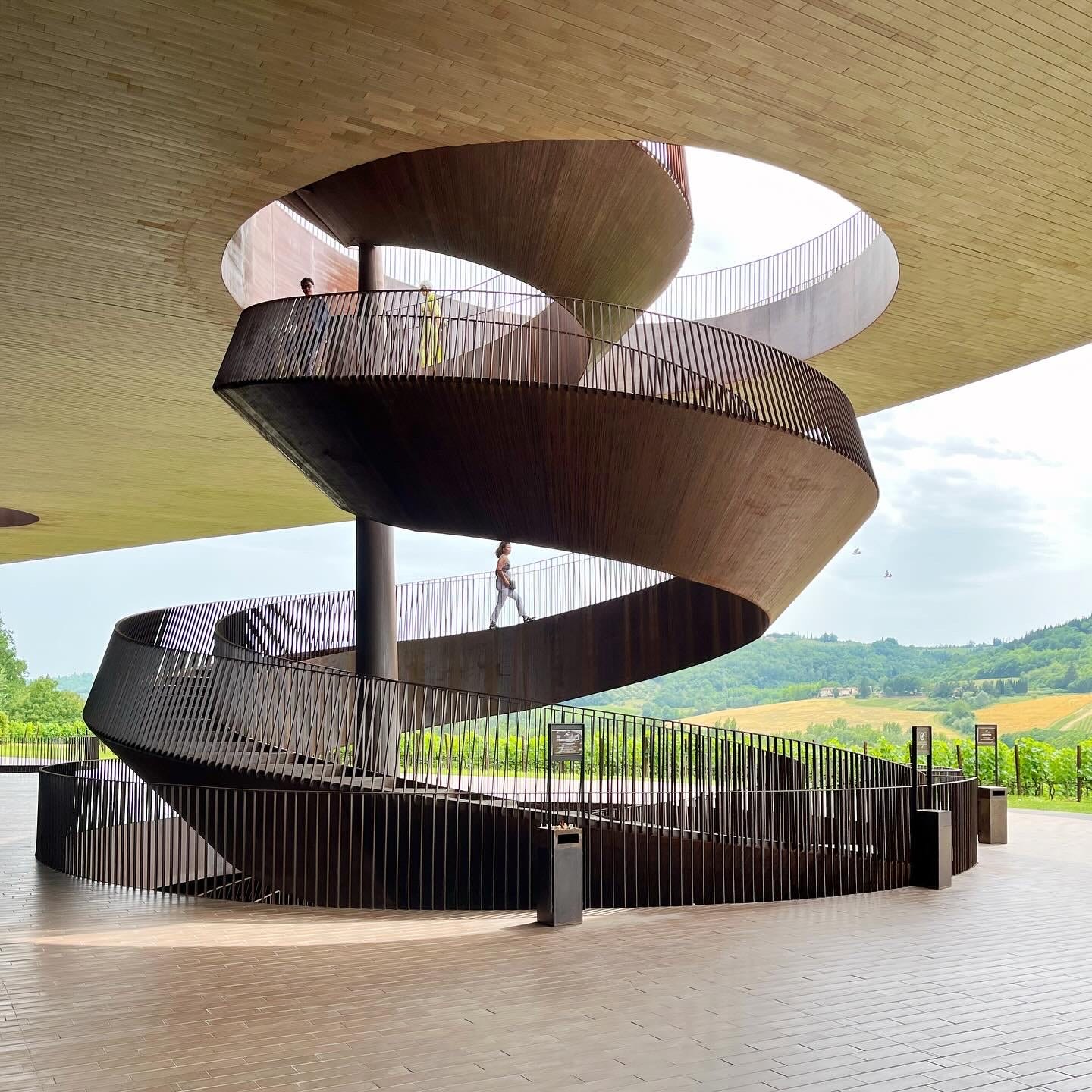
We have spent many a sunny winter day soaking in the thermal pool at Hotel La Posta in Bagna Vignone. There are so many good restaurants there too.
What Sara has. created with Violino D’Oro in Venice is truly a jewel.